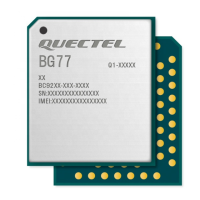LPWA Module Series
BG77 Hardware Design
BG77_Hardware_Design 56 / 76
In order to ensure RF performance and reliability, the following principles should be complied with in RF
layout design:
Use impedance simulation tool to control the characteristic impedance of RF traces as 50Ω.
The GND pins adjacent to RF pins should not be designed as thermal relief pads, and should be fully
connected to ground.
The distance between the RF pins and the RF connector should be as short as possible, and all the
right angle traces should be changed to curved ones.
There should be clearance area under the signal pin of the antenna connector or solder joint.
The reference ground of RF traces should be complete. Meanwhile, adding some ground vias around
RF traces and the reference ground could help to improve RF performance. The distance between
the ground vias and RF traces should be no less than two times the width of RF signal traces (2*W).
For more details about RF layout, please refer to document [4].
5.2. GNSS Antenna Interface
The following tables show the pin definition and frequency specification of GNSS antenna interface.
Table 32: Pin Definition of GNSS Antenna Interface
Table 33: GNSS Frequency
A reference design of GNSS antenna interface is shown as below.
Pin Name Pin No. I/O Description Comment
ANT_GNSS 32 AI GNSS antenna interface 50Ω impedance
Type Frequency Unit
GPS 1575.42±1.023 MHz
GLONASS 1597.5~1605.8 MHz
Galileo 1575.42±2.046 MHz
BeiDou 1561.098±2.046 MHz
QZSS 1575.42±1.023 MHZ

